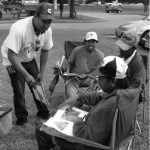labor rights
Celebrity chef John Besh has joined Harvey Weinstein and Bill O’Reilly in news headlines about sexual harassment in the workplace. The New Orleans-based Besh has received numerous James Beard awards and has appeared on the Bravo TV network’s show Top Chef. His offenses were reported this week by Brett Anderson at The Times-Picayune. The reporter’s eight-month long investigation included interviews with 25 current and former employees of the Besh Restaurant Group.
Brett Anderson’s story includes a copy of one of the EEOC complaints filed by a former employee. That employee says…
At Reveal, Amy Julia Harris and Shoshana Walter investigate an increasing criminal justice trend in which defendants are sent to rehab, instead of prison. On its face, the idea is a good one, especially for people struggling with addiction. However, the reporters find that many so-called rehab centers are little more than labor camps funneling unpaid workers into private industry.
The story focused on one particular center, Christian Alcoholics & Addicts in Recovery (CAAIR) in Oklahoma. Started by chicken company executives, CAAIR’s court-ordered residents work full-time at Simmons Foods…
At the Toronto Star, reporter Sara Mojtehedzadeh went undercover as a temp worker at Fiera Foods, an industrial bakery, to investigate why temp workers are more likely to get hurt on the job. Earlier this year, Canadian occupational health and safety officials brought charges against the company, whose clients include Dunkin’ Donuts, Costco and Walmart, for the death of 23-year-old Amina Diaby, who was strangled to death after her hijab got caught in a machine.
Mojtehedzadeh, along with Brendan Kennedy, write:
I get about five minutes of training in a factory packed with industrial equipment…
The whole world is one global supply chain. Brand name companies like Nike, Apple, Hasbro, and dozens of apparel companies do not actually make the consumer products they sell. Instead they hire contract manufacturers in the developing world to produce their goods, and these contractors have sub-contractors, and sub-sub-contractors, all the way down to industrial homework in workers’ homes. Global supply chains start with processing the products’ raw materials, manufacturing parts and the finished product, and then transportation to the consumer.
How can a conscientious consumer or…
At the Huffington Post, Dave Jamieson reports that labor unions are stepping up to help protect increasingly vulnerable immigrant workers from deportation. In fact, Jamieson writes that in many instances, labor unions have become “de facto immigrants rights groups,” educating workers on their rights and teaching immigrants how to best handle encounters with immigration officials.
Jamieson’s story begins:
Yahaira Burgos was fearing the worst when her husband, Juan Vivares, reported to the Immigration and Customs Enforcement office in lower Manhattan in March. Vivares, who fled Colombia and…
Typically, we like to end the annual “The Year in U.S. Occupational Health & Safety” on an uplifting note. But this time around — to be honest — that was a hard sell.
Take a quick look through the 2017 yearbook and you’ll quickly glean that worker health and safety is very much at risk under the new administration and from lawmakers in the states. From the attempted rollback of a new federal beryllium exposure standard to state efforts to weaken workers’ compensation systems, the view from 2017 does not seem terribly promising. On the other hand, the fight for workers’ rights has never…
Investigative journalists play an important role in raising public awareness about worker health and safety issues. The number and quality of stories over the last 12 months was exceptional so "The Year in U.S. Occupational Health & Safety" includes a full section which highlights our picks for top-notch reporting.
The stories that Kim and I profile in Section III of the yearbook include the following:
A three-part investigation by NBC Bay Area that examined the workers’ compensation system in California. In one city, the medical claims of nearly 70 firefighters were denied and the…
Kim Krisberg and I published yesterday---Labor Day 2017---the sixth edition of "The Year in U.S. Occupational Health & Safety." It’s our effort to record the key events which advanced (or degraded) worker safety protections in the last 12 months. Kim's blog post yesterday provided an overview of the yearbook. I offer today a snapshot of the yearbook’s first section which addresses high points and low points of actions at the federal level.
Last year the OHS community bid farewell to Joe Main and David Michaels, the assistant secretaries of labor for MSHA and OSHA,…
For the sixth year in a row, we present “The Year in U.S. Occupational Health & Safety,” our attempt to document the year’s highs and lows as well as the challenges ahead.
Like previous editions, the 2017 yearbook highlights policies, appointments and activities at the federal, state and local levels; outstanding news reporting on workers’ rights, safety and health; and the latest research from public health agencies and worker groups on the ground. Of course, you can’t ignore the giant elephant (no pun intended) in the room in 2017 — a new president and a Republican-controlled Congress…
Massive “clean-up” projects are underway in Houston and the surrounding region. As the waters brought by Hurricane Harvey recede, individuals seeking work---day laborers---will be assembling in damaged neighborhoods and offering their skills. It was a commonplace scene following Superstorm Sandy's destruction in 2012, and in Harvey’s disaster zone, day laborers are already on street corners and in parking lots offering to work.
I hope the workers’ experiences from Superstorm Sandy are lessons being reviewed by officials, leaders, and funders in Houston. It would be time well spent if they…
Drivers honked and waved. They gave thumbs up to the 30 people on the sidewalk. The group was holding signs outside a North Carolina poultry plant. “El baño” – the bathroom – was the word catching the drivers’ attention.
The scene on August 14 was a demonstration in front of the Case Farms poultry plant in Morganton, NC. The company supplies chicken to KFC, Popeyes, and Taco Bell.
Alisa Olvera outside of Case Farms poultry plant in Morganton, NC.
The reason for the peaceful protest?
The Case Farms plant has a sanitation problem. Workers don’t have access to the bathroom when they need to…
At the Tampa Bay Times, Neil Bedi, Jonathan Capriel, Anastasia Dawson and Kathleen McGrory investigate a June 29 incident at Tampa Electric in which molten ash — commonly referred to as “slag” — escaped from a boiler and poured downed on workers below. Five workers died.
A similar incident occurred at Tampa Electric two decades earlier. If the company had followed the guidelines it devised after that 1997 incident, the five men who died in June would still be alive, the newspaper reported. In particular, the five deaths could have been avoided if the boiler had been turned off before workers…
At The New York Times, Elizabeth Olson writes about the challenges that older workers face in proving workplace bias. She begins the story with Donetta Raymond, a longtime manufacturing worker laid off, along with hundreds of others, by Spirit AeroSystems Holdings. Now, some of those workers are bringing a lawsuit after discovering that nearly half of the laid-off workers were 40 or older, the age when federal age discrimination protections kick in. Olson writes:
Such lawsuits are popping up as the nation’s work force ages and as many longtime workers claim that they are being deliberately…
At PBS Newhour, Aubrey Aden-Buie reports on the shipbuilders that receive billions in federal contracts despite histories of serious safety lapses. In a review of federal contracts, Aden-Buie and colleagues found that since 2008, the federal government has awarded more than $100 billion to companies with records of safety incidents that injured and killed workers.
In a transcript of the broadcast (which you can also watch at the link above), Aden-Buie interviews Martin Osborn, a welder at shipbuilder Austal USA in Alabama:
MARTIN OSBORN: I was up in a boom lift, as we call it, or a man…
I spend most of my time these summer days in cool air-conditioned (AC) environments. I feel the 100 degree heat when I’m going from one AC-cooled building to another. For me, the intense central Texas heat is something that is “out there” not "in here." But I was reminded today of people whose jobs cause them to say “it’s an oven in there.” An acquaintance's husband works as an auto mechanic. The garage where he works normally has a couple of large fans to circulate the air. Today one of the fans broke down. Temperatures inside the garage matched the outdoor temperature of nearly 100…
Two global unions, four labor rights organizations and 23 apparel brands and retailers agreed in late June to amend and extend the ground-breaking Bangladesh Accord on Fire and Building Safety that has led to safer working conditions for 4 million garment workers in the world’s #2 apparel producer. The legally-binding agreement, initiated in 2013 following the Rana Plaza building collapse that killed 1,138 workers in Dhaka, is a success story that could improve working conditions in other countries and global supply chains.
The new Accord agreement, which goes into effect in May 2018…
At the Intercept, Avi Asher-Schapiro reports on a new insurance plan that Uber is offering its drivers that could help them recoup wages and cover medical expenses if they’re injured on the job. Asher-Schapiro notes that while some have described the Uber insurance plan — which workers buy by setting aside 3.75 cents per mile — as a form of workers’ compensation, it hardly fits the bill. In fact, in documents obtained by the Intercept, Uber explicitly states that the insurance plan isn’t workers’ comp. He writes:
Compared to traditional workers’ compensation insurance, Uber’s policy…
At the Center for Public Integrity, a five-part investigative series on safety at the nation’s nuclear facilities finds that workers can and do suffer serious injuries, yet the Department of Energy typically imposes only minimal fines for safety incidents and companies get to keep a majority of their profits, which does little to improve working conditions. Reporters estimated that the number of safety incidents has tripled since 2013.
For example, in 2009, the chair of a safety committee at Idaho National Laboratory told high-ranking managers that damaged plutonium plates could put workers…
I had one ear tuned this morning to the webcast of Labor Secretary Alex Acosta’s appearance before a subcommittee of the Appropriations Committee on his Department’s FY 2018 budget request. You never know what bumble bee might be in a lawmaker’s bonnet or how they might use their time to gush about Department-funded pet project in their home State. That's why I tuned in.
Two moments during the hearing were most memorable to me. The first involved Tennessee Senator Lamar Alexander (R) who expressed dissatisfaction with the Administration’s slow pace of nominating individuals for top jobs at…
Tesla held its annual stockholder meeting this month, and co-founder/CEO Elon Musk was asked to speak about worker safety problems at their plants. He briefly mentioned the topic in his prepared remarks, but was probed later about it by a stockholder. The question came from @sunabeepdeep who asked:
"What changes are being made to address worker safety?"
Public attention on working conditions at Tesla’s manufacturing plant in Fremont, CA was prompted most recently by a May 18 story in The Guardian. Reporter Julia Carrie Wong spoke to current and former employees who described intense…



